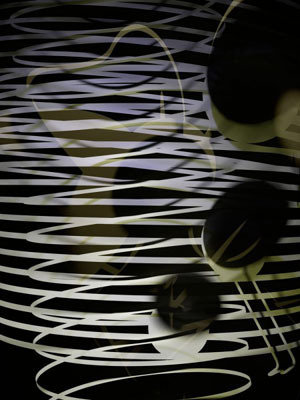Thomas Ruff
dal 27/3/2013 al 26/4/2013
Segnalato da
27/3/2013
Thomas Ruff
David Zwirner, New York
The photograms and ma.r.s. works presented in this exhibition continue his interest in visual verisimilitude, with each series exploring the mutability and material presence of the photographic image.

David Zwirner is pleased to present an exhibition of two bodies of works
by Thomas Ruff, including the world premiere of the series photograms.
On view in the gallery’s 525 and 533 West 19th Street spaces in New
York, this will be the photographer’s seventh solo show since he joined
David Zwirner in 2000.
Working in distinct series since the late 1970s, Ruff has approached
different genres of photography, including portraiture, architecture,
astronomy, the nude, surveillance imagery, and reportage. Using a
wide range of technological approaches, and often pushing the limits
of photographic representation in the process, he has reinvented
many historical conventions and expectations of the medium. The
photograms and ma.r.s. works presented in this exhibition continue his
interest in visual verisimilitude, with each series exploring the mutability
and material presence of the photographic image.
The photograms depict abstract shapes, lines, and spirals in
seemingly random formations with varying degrees of transparency
and illumination. Their compositions are reminiscent of artistic experimentation with camera-less photography in
the 1920s, where objects were placed directly on photo-sensitive paper and exposed to light, creating white or gray
silhouettes wherever they made contact. Cherished in particular by Surrealists, such photograms were governed by
unanticipated light effects, allowing for the element of chance in the final result. Yet both the objects and the light in
Ruff’s “photograms” derive from a virtual darkroom built by a custom-made software program, giving the artist more
control over the outcome.
Ruff adds colors to his photograms (a departure from the monochrome tones of traditional versions), creating visually
complex, illusory arrangements of foreground and background, definition and blur. The composition of each work
appears to present a fragment of a larger, continuous whole, much like the artist’s photographs of stars and galaxies
gathered from negatives bought from the European Southern Observatory, but ultimately corresponding to his
own pictorial scheme (stars was started in 1989). As in this earlier series, Ruff’s photograms are autonomous from
actual referents.
By invoking early twentieth-century processes—which in the hands of artists like László Moholy-Nagy and Man Ray
carried revolutionary promises of a more direct representation of light than photography mediated by a camera—Ruff’s
photograms suggest an equally radical method of simulating light using calculations based on optics. Their digital
generation raises broader questions about what constitutes photography, and ultimately touches upon the issue of the
medium’s veracity.
The works in Ruff’s ma.r.s. series, many of which will be on view for the first time, are based on black-and-white satellite
photographs of the surface of Mars, taken by high-resolution cameras aboard NASA spacecraft (“ma.r.s.” stands for
“Mars Reconnaissance Survey”). Studied by scientists for information about the planet’s geology and potential landing
sites for future visits, these reveal extreme close-ups of the planet’s rugged surface, until recently unseen by anyone.
Downloading the pictures from NASA’s website, Ruff digitally altered the images, changed the perspective, and added
color. The resulting chromogenic prints transform the originals into visual statements that are at once documentary and
fictional. Evocative of abstract and minimalist compositions, some surfaces have been rendered as 3D images, using
a technique originally developed in the nineteenth century to convey the illusion of depth. Indicative of NASA’s own
efforts to measure topographic highs and lows, these works, as the artist has put it, “add an aspect of the absurd, in the
fact that you can actually recognize deep relief on the surface of another planet with cheap 3D glasses.”
Born in 1958 in Zell am Harmersbach, Germany, Thomas Ruff attended the Staatlichen Kunstakademie in Düsseldorf
from 1977 to 1985.
Ruff’s work has been the subject of solo exhibitions at prominent venues internationally, most recently in 2012 with a
large-scale, comprehensive survey presented at the Haus der Kunst in Munich. Other recent solo exhibitions include
those organized by the LWL-Landesmuseum für Kunst und Kulturgeschichte, Münster, Germany; Centro de Arte
Contemporáneo de Málaga, Spain (both 2011); Castello di Rivoli, Turin; Museum für Neue Kunst, Freiburg, Germany;
Kunsthalle Wien, Vienna (all 2009); Mucsarnok Kunsthalle, Budapest (2008); Moderna Museet, Stockholm; and the Sprengel Museum Hannover, Germany (both 2007).
Work by the artist is held in museum collections worldwide, including The Art Institute of Chicago; Dallas Museum of
Art; Essl Museum, Klosterneuburg, Austria; Hamburger Bahnhof - Museum für Gegenwart, Berlin; Hirshhorn Museum
and Sculpture Garden, Washington, D.C.; The Metropolitan Museum of Art, New York; Moderna Museet, Stockholm;
National Gallery of Victoria, Melbourne; National Museum of Photography, Copenhagen; Solomon R. Guggenheim
Museum, New York; and the Stedelijk Museum voor Actuele Kunst (S.M.A.K.), Ghent. He lives and works in Düsseldorf.
For all press inquiries, please contact
Kim Donica at David Zwirner 212-727-2070 kim@davidzwirner.com
Opening reception: Thursday, March 28, 6 – 8 PM
Press preview with the artist: Thursday, March 28, 10 AM
David Zwirner
525 West 19th Street, New York
Hours: Tuesday – Saturday, 10 AM – 6 PM
Monday by appointment
Free Admission



